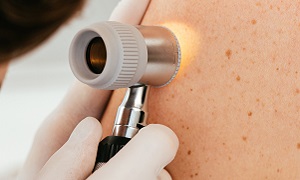Cancerous Mole
Cancerous mole is typically a new mole or an existing one, which has gone through a few changes. A cancerous mole is also known to be the most common sign of melanoma of the skin. Every new or changing mole, however, is not cancerous, and therefore, it is better to keep track of the moles.
Melanoma is not the most common form of skin cancer, but it is known to be the most serious one. This is due to the fact that it can spread very fast to other parts of the body, and make treatment difficult and thus resulting in a poor outlook.
These moles may occur anywhere in one’s body, and the appearance can also vary in shape and size.
Getting an early diagnosis and receiving proper treatment as soon as possible, is important, and it can improve the outlook for people having melanoma. This is why proper vigilance is important as well as regularly checking the skin.
Symptoms
Identifying a cancerous mole in the early stages of melanoma can be a little difficult. Due to this reason, people should consider checking their skin regularly for signs of any change, such as a new mole or a change in the appearance of any existing moles.
If a person suspects that a mole might be cancerous, it is important for them to see their dermatologist for a proper diagnosis.
Some of the symptoms that you should be aware of include the following:
- Any changes to the skin, such as a new mole or a change in the color, size, and of an existing mole
- A mole that has a shiny, waxy, smooth, or pale appearance
- A firm, red lump that bleeds or appears crusty
- A mole that does not heal or becomes painful or tender
- A mole that gets itchy or starts to bleed
- A flat, red spot that can be rough, dry, or scaly
You can follow the ABCDE examination rule as well, to check for potentially cancerous moles. This rule describes five simple characteristics of early melanoma. These features include the following:
- Asymmetry: One half of a cancerous mole is generally likely to look different as compared to the other half.
- Border: The edges might be ragged, notched, or blurred rather than smooth.
- Color: They may contain uneven colors and shades, which can be black, brown, or tan. Some might even include white, pink, red, grey, or blue areas
- Diameter: Cancerous moles generally change in size, and usually grow larger. If a mole gets larger than 6 millimeters, it might be cancerous.
- Evolving: A change in the appearance of a mole over weeks or months can also indicate that it is cancerous.
You may also want to remember that only around 20-30% percent of melanoma cases arise from a pre-existing mole. The majority presents as a new mole.
Causes
Scientists are still trying to understand the exact cause of cancerous moles. The most common reason is believed to a combination of genetic and environmental factors.
Excessive exposure to UV light is known to be the most common cause of cancerous moles. The main source of UV light is sunlight, as well as artificial sources of light, which includes tanning beds, as well as other gadgets that produce UV light.
People who have atypical mole syndrome are usually at high risk of developing this condition. The syndrome is associated with the following three characteristics:
- More than a hundred moles
- One or more moles that are 8mm or larger in diameter
- Multiple cancerous moles
Diagnosis
You should be able to detect the symptoms of a cancerous mole by using the ABCDE rule and regularly examining your skin for any new and existing moles.
People should also try to check all the areas of their skin, which includes their back and other areas which might be difficult to see without any assistance. You can use a mirror or your phone camera, or ask a friend or family member to check it for you.
If you are having concerns or worries about a mole, then you should see a dermatologist, who can use microscopic or photographic tools in order to examine a mole in more detail. Dermatologists are specially trained to identify abnormal moles as well as melanomas. However, even with their years of training, sometimes this can prove to be difficult.
If your dermatologist suspects a cancerous mole, he/she might order a biopsy. This procedure involves a healthcare professional taking a sample of a mole and sending it to the laboratory for examination.
Treatment
Treatment for a cancerous mole is mostly the same as other cancers. However, unlike cancers of the internal organs, it will be easier to assess the cancerous tissue and remove the mole using surgery. Surgery is therefore the most common treatment option for most cancerous moles.
The procedure generally involves removing the mole along with some of the surrounding non-cancerous tissue around it. In certain cases, when a person has received an early diagnosis, surgery might be a sufficient remedy for treating the cancerous mole. If the mole covers a large area of the skin, a skin graft might also be required after the surgery.
Generally, a surgeon is ‘going to perform the excision while a person is under local anesthesia. This means that the person is conscious during the procedure, though they will not be feeling any pain, as the affected area will be numbed.
If there is any risk that your cancer has spread into your organs, blood, or your bones, then a doctor might perform a further examination, such as lymph node surgery, biopsy, radiologic studies, etc.
If your cancer has spread, then a doctor is going to perform a few other procedures which can include any of the following:
- Radiation Therapy
- Chemotherapy
- Targeted Therapy
- Immunotherapy




